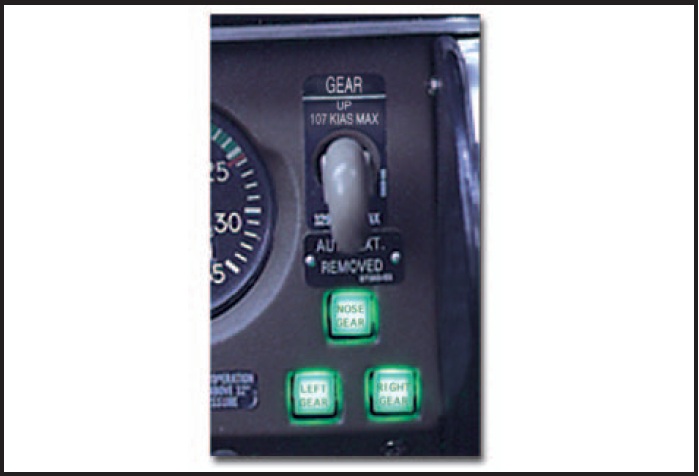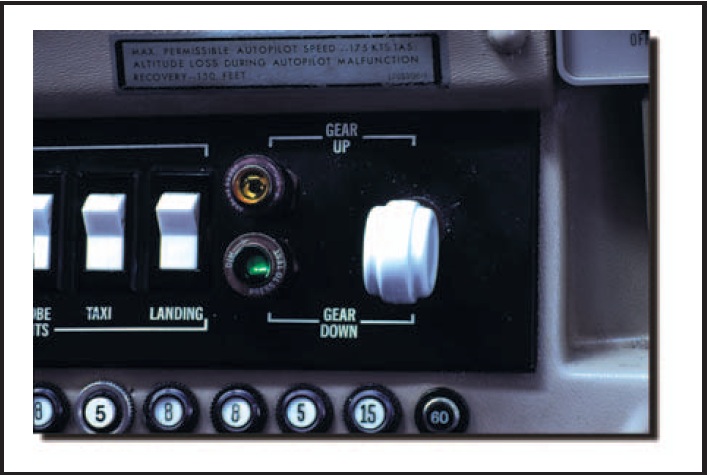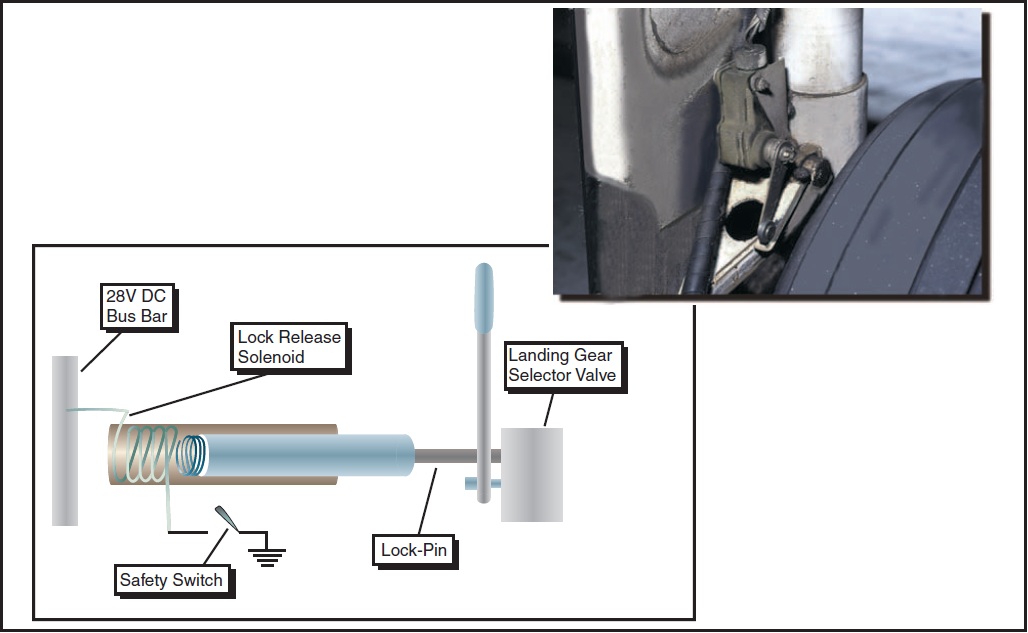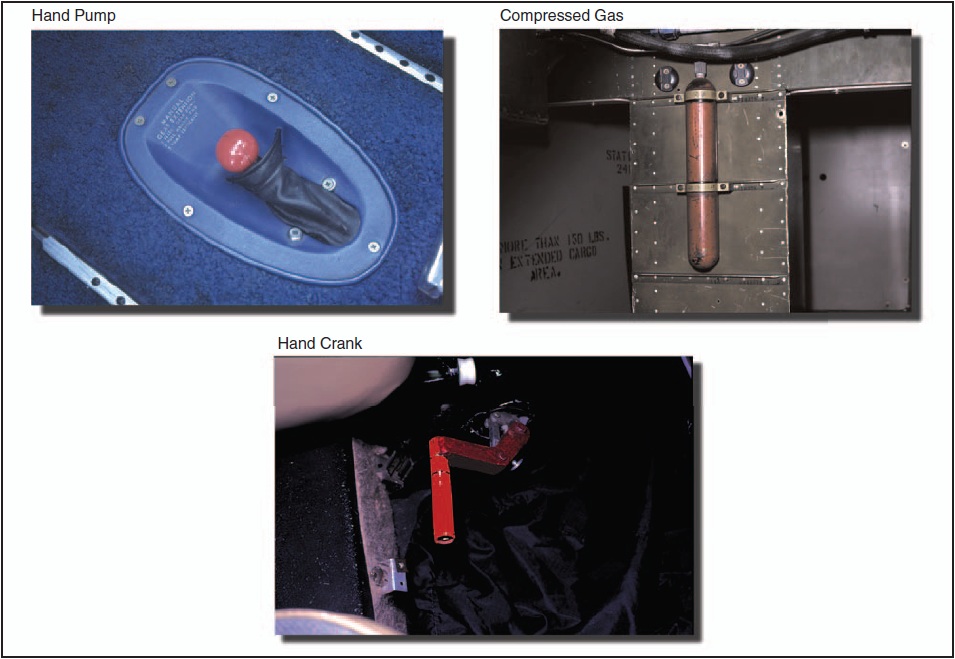
11—Transition to Complex Airplanes
Table of Contents
High Performance and Complex Airplanes
Wing Flaps
Function of Flaps
Flap Effectiveness
Operational Procedures
Controllable-Pitch Propeller
Constant-Speed Propeller
Takeoff, Climb, and Cruise
Blade Angle Control
Governing Range
Constant-Speed Propeller Operation
Turbocharging
Ground Boosting vs. Altitude Turbocharging
Operating Characteristics
Heat Management
Turbocharger Failure
Overboost Condition
Low Manifold Pressure
Retractable Landing Gear
Landing Gear Systems
Controls and Position Indicators
Landing Gear Safety Devices
Emergency Gear Extension Systems
Operational Procedures PreFlight
Takeoff and Climb
Approach and Landing
Transition Training

RETRACTABLE LANDING GEAR
The primary benefits of being able to retract the landing gear are increased climb performance and higher cruise airspeeds due to the resulting decrease in drag. Retractable landing gear systems may be operated either hydraulically or electrically, or may employ a combination of the two systems. Warning indicators are provided in the cockpit to show the pilot when the wheels are down and locked and when they are up and locked or if they are in intermediate positions. Systems for emergency operation are also provided. The complexity of the retractable landing gear system requires that specific operating procedures be adhered to and that certain operating limitations not be exceeded.
LANDING GEAR SYSTEMS
An electrical landing gear retraction system utilizes an electrically driven motor for gear operation. The system is basically an electrically driven jack for raising and lowering the gear. When a switch in the cockpit is moved to the UP position, the electric motor operates. Through a system of shafts, gears, adapters, an actuator screw, and a torque tube, a force is transmitted to the drag strut linkages. Thus, the gear retracts and locks. Struts are also activated that open and close the gear doors. If the switch is moved to the DOWN position, the motor reverses and the gear moves down and locks. Once activated the gear motor will continue to operate until an up or down limit switch on the motor’s gearbox is tripped.
A hydraulic landing gear retraction system utilizes pressurized hydraulic fluid to actuate linkages to raise and lower the gear. When a switch in the cockpit is moved to the UP position, hydraulic fluid is directed into the gear up line. The fluid flows through sequenced valves and downlocks to the gear actuating cylinders. A similar process occurs during gear extension. The pump which pressurizes the fluid in the system can be either engine driven or electrically powered. If an electrically powered pump is used to pressurize the fluid, the system is referred to as an electrohydraulic system. The system also incorporates a hydraulic reservoir to contain excess fluid, and to provide a means of determining system fluid level.
Regardless of its power source, the hydraulic pump is designed to operate within a specific range. When a sensor detects excessive pressure, a relief valve within the pump opens, and hydraulic pressure is routed back to the reservoir. Another type of relief valve prevents excessive pressure that may result from thermal expansion. Hydraulic pressure is also regulated by limit switches. Each gear has two limit switches—one dedicated to extension and one dedicated to retraction. These switches de-energize the hydraulic pump after the landing gear has completed its gear cycle. In the event of limit switch failure, a backup pressure relief valve activates to relieve excess system pressure.
Ch 11.qxd 5/7/04 8:50 AM Page 11-10
CONTROLS AND POSITION INDICATORS
Landing gear position is controlled by a switch in the cockpit. In most airplanes, the gear switch is shaped like a wheel in order to facilitate positive identification and to differentiate it from other cockpit controls. [Figure 11-6]

Figure 11-6. Typical landing gear switches and position indicators.
Landing gear position indicators vary with different make and model airplanes. The most common types of landing gear position indicators utilize a group of lights. One type consists of a group of three green lights, which illuminate when the landing gear is down and locked. [Figure 11-6] Another type consists of one green light to indicate when the landing gear is down and an amber light to indicate when the gear is up. Still other systems incorporate a red or amber light to indicate when the gear is in transit or unsafe for landing. [Figure 11-7] The lights are usually of the “press to test” type, and the bulbs are interchangeable. [Figure 11-6]

Figure 11-7. Typical landing gear switches and position indicators.
Other types of landing gear position indicators consist of tab-type indicators with markings “UP” to indicate the gear is up and locked, a display of red and white diagonal stripes to show when the gear is unlocked, or a silhouette of each gear to indicate when it locks in the DOWN position.
LANDING GEAR SAFETY DEVICES
Most airplanes with a retractable landing gear have a gear warning horn that will sound when the airplane is configured for landing and the landing gear is not down and locked. Normally, the horn is linked to the throttle or flap position, and/or the airspeed indicator so that when the airplane is below a certain airspeed, configuration, or power setting with the gear retracted, the warning horn will sound.
Accidental retraction of a landing gear may be prevented by such devices as mechanical downlocks, safety switches, and ground locks. Mechanical downlocks are built-in components of a gear retraction system and are operated automatically by the gear retraction system. To prevent accidental operation of the downlocks, and inadvertent landing gear retraction while the airplane is on the ground, electrically operated safety switches are installed.
A landing gear safety switch, sometimes referred to as a squat switch, is usually mounted in a bracket on one of the main gear shock struts. [Figure 11-8] When the strut is compressed by the weight of the airplane, the switch opens the electrical circuit to the motor or mechanism that powers retraction. In this way, if the landing gear switch in the cockpit is placed in the RETRACT position when weight is on the gear, the gear will remain extended, and the warning horn may sound as an alert to the unsafe condition. Once the weight is off the gear, however, such as on takeoff, the safety switch will release and the gear will retract.

Figure 11-8. Landing gear safety switch.
Many airplanes are equipped with additional safety devices to prevent collapse of the gear when the airplane is on the ground. These devices are called ground locks. One common type is a pin installed in aligned holes drilled in two or more units of the landing gear support structure. Another type is a spring-loaded clip designed to fit around and hold two or more units of the support structure together. All types of ground locks usually have red streamers permanently attached to them to readily indicate whether or not they are installed.
EMERGENCY GEAR EXTENSION SYSTEMS
The emergency extension system lowers the landing gear if the main power system fails. Some airplanes have an emergency release handle in the cockpit, releases the uplocks and allows the gears to free fall, or which is connected through a mechanical linkage to extend under their own weight. [Figure 11-9] the gear uplocks. When the handle is operated, it releases the uplocks and allows the gears to free fall, or extend under their own weight. [Figure 11-9]

Figure 11-9. Typical emergency gear extension systems.
On other airplanes, release of the uplock is accomplished using compressed gas, which is directed to uplock release cylinders.
In some airplanes, design configurations make emergency extension of the landing gear by gravity and air loads alone impossible or impractical. In these airplanes, provisions are included for forceful gear extension in an emergency. Some installations are designed so that either hydraulic fluid or compressed gas provides the necessary pressure, while others use a manual system such as a hand crank for emergency gear extension. [Figure 11-9] Hydraulic pressure for emergency operation of the landing gear may be provided by an auxiliary hand pump, an accumulator, or an electrically powered hydraulic pump depending on the design of the airplane.
11-10
Ch 11.qxd 5/7/04 8:50 AM Page 11-11
Ch 11.qxd 5/7/04 8:50 AM Page 11-12
PED Publication